Vortex Bladeless – Energy from an oscillating stick?
When it comes to utility-scale wind power, regular wind turbines rule supreme.
But when it comes to small-scale wind generation, particularly in urban areas, no conclusive technology has come on top.
There is no wind tech capable of competing with or complementing solar panels.
In this article, we will look at one solution in particular: The Vortex bladeless wind generator, a baseball bat-looking structure that can produce energy by oscillating in the wind instead of rotating.
Contents
- Before anything, why not just use small wind turbines?
- So how about Vertical-axis wind turbines (VAWTs)?
- How do Vortex bladeless devices generate electricity?
- Why is it better than other small-scale wind turbines?
- If it’s so amazing, why is it not out yet?
- Conclusion
- Resources
Before anything, why not just use small wind turbines?
Let’s start by addressing the elephant in the room. Why can’t we just use smaller horizontal-axis wind turbines (the regular ones we see on Danish postcards), instead of having to look for novel solutions using alternative physics?
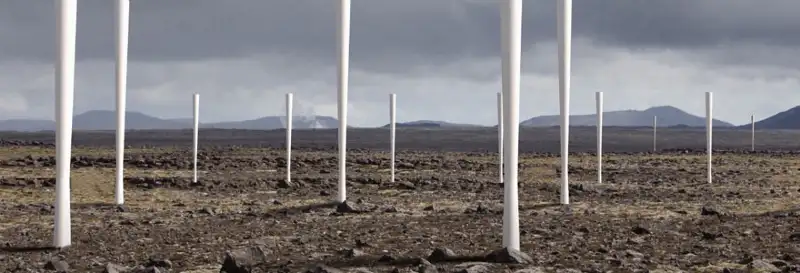
Squared relationship with turbine height and sweep area
Firstly, regular wind turbines work best under high-quality, laminar winds caused by smooth consistent prevailing winds widely available in the oceans and at heights.
This is why turbines are getting bigger (longer blades) and taller (tap into higher winds), because each additional cm of blade and each cm taller in height increases the energy significantly.
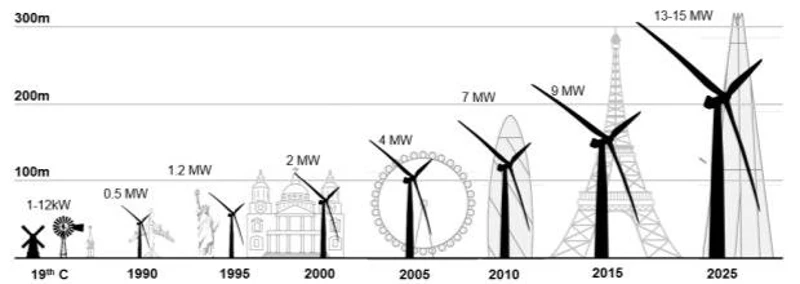
Making them smaller significantly reduces the amount of energy that could be harnessed. Add the turbulent, gusty winds of an urban maze and you have effectively rendered wind energy useless.
Not a snug fit for the city
It’s certainly not easy to fit in rapidly rotating blades within the city. Not only is there a lack of space, but it’s also a safety hazard.
Firstly, turbines require strong foundations and buildings don’t often have the in-built strength. The forces exerted by the turbines on the building over a long time period may lead to material fatigue.
Obvous locations for small wind turbines are building rooftops, but these could be given different utility in cities. Rooftop bars, rooftop gardens, telecomm antennas or solar panel installations come to mind.
Competition with solar
Unless you live in polar regions where winds are significantly more reliable than the sun, solar panels are significantly simpler, cheaper and less visually obvious than wind turbines.
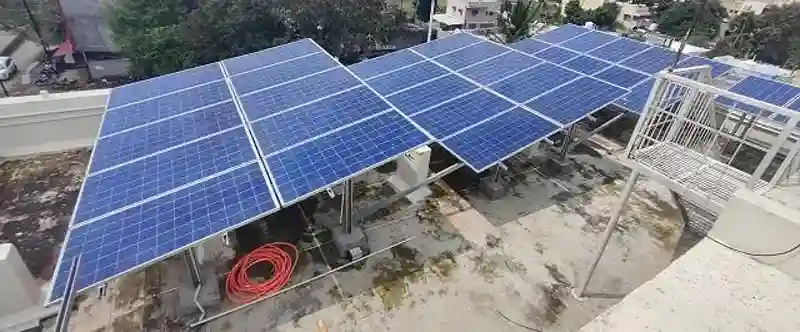
This is why even countries like Germany which are at high latitudes have large amounts of solar capacity installed.
So how about Vertical-axis wind turbines (VAWTs)?
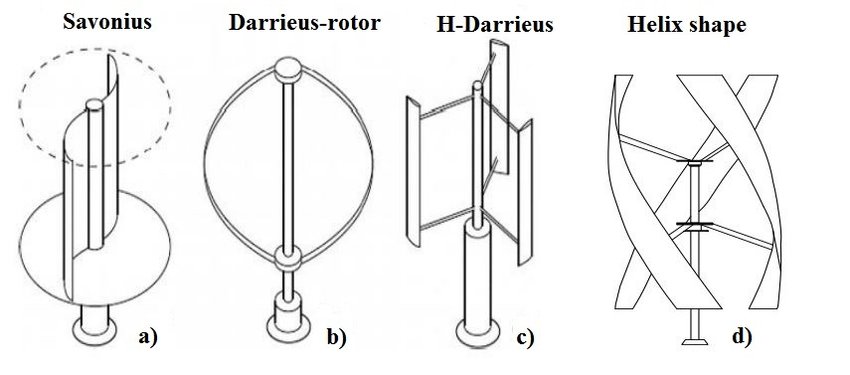
This type of turbine is actually the status quo of DIY and small-scale turbines. They can be simple or complex, but the idea is that having blades rotating vertically takes up significantly less space and can take better advantage of more chaotic winds.
These are probably the number one, proven candidates for small-scale applications, particularly in urban environments, but it still suffers from the maintenance and noise dilemma that plagues all energy generation with moving parts.
Perhaps, a solution iterating from VAWTs will rise above all the other ones, with most of the other ‘novel’ urban wind generation projects being nothing more than a marketing ploy looking for a million-dollar raise.
But beyond all the proposed solutions, we have found Vortex bladeless wind generators as one of the most convincing, so let’s finally delve in!
How do Vortex bladeless devices generate electricity?
Energy from turbulence, not lift
Vortex devices are vertical structures that generate electricity by oscillating in the wind. The oscillating part of the device is loaded with magnets that induce a current on a copper wire that remains static at the core, as per the diagram below.
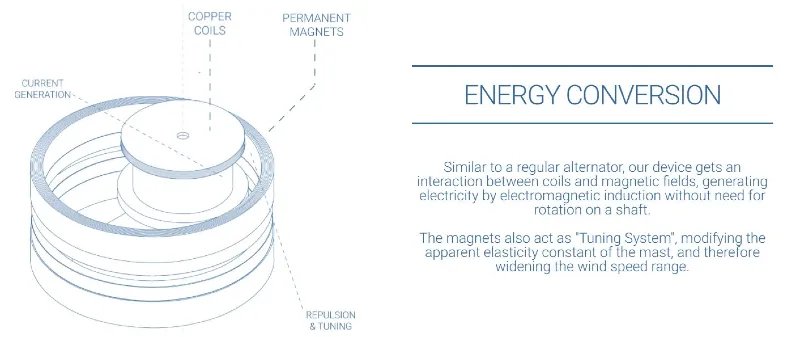
The oscillation is first initiated by the push force of the wind, but as the device starts recoiling back, it starts getting ‘in tune’ with the wind speed, just like when you see a flag flapping ‘at the tune of the wind’.
This ‘tuning’ is actually the result of an invisible phenomenon called Vortex Shedding, which occurs when any fixed device like the Vortex is exposed to wind speeds that match its natural frequency.
These rotating air features are essentially low-pressure areas that pull objects towards them, meaning that if a stationary structure like the Vortex has the ability to bend, it will oscillate as the same turbulence it produces pulls it from one side to the other.
The ‘whirling’ turbulence that is produced downwind is essentially made of low-pressure areas that pull objects towards them, meaning that if a stationary structure like the Vortex has the ability to bend, it will do so towards the ‘sucking’ air vortices.

Where does the idea come from?
This harmonic oscillation is exactly what happened when the Tacoma Narrows bridge famously collapsed in 1940 before this phenomenon was widely understood and taken into consideration at the design stage.
The suspension bridge was known as “Galloping Gertie” during its initial 4 months until one particularly windy day when the wind speeds matched its frequency perfectly, causing the bridge to oscillate into oblivion.
All while providing the inspiration to harness energy from this phenomenon.
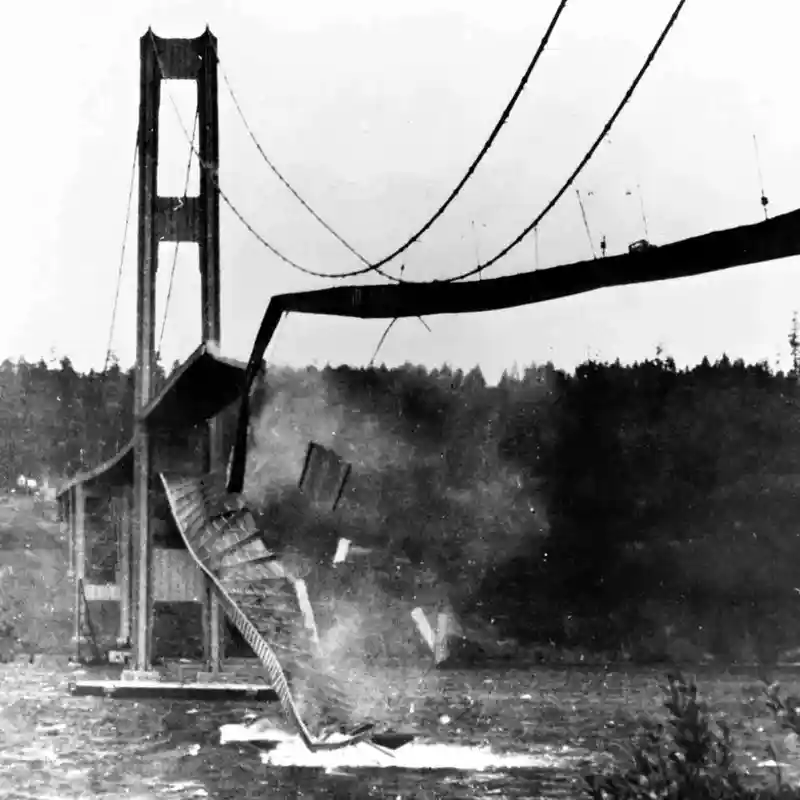
How does it stay at the right frequency for oscillation?
It took four months for the Tacoma Bridge to collapse because in reality, wind speeds are always changing, particularly in urban environments where winds become gusty and turbulent due to the influence of buildings.
This means that the Vortex device wouldn’t be able to reach its ideal ‘harmonic’ state most of the time, as the resonance frequency of an object depends on its shape and material properties, which are in-built.
But the team came up with an elegant solution to this problem. The Vortex device can adjust its resonating frequency by adjusting the magnetic force of its magnets.
It can put a bit more resistance to oscillation when speeds rise above its frequency and induce attraction when speeds are lower than its natural frequency! Smart right?
Why is it better than other small-scale wind turbines?
Through the novel use of alternative physics, the Vortex bladeless device may just have the edge in the small-scale wind generation market, particularly in urban environments. Here’s why:
Lower cost
The Vortex’s design is much simpler than that of wind turbines, potentially making them less costly to mass-produce, with estimates for the 2.75m high Tacoma model potentially going within the 100s of Euros each.
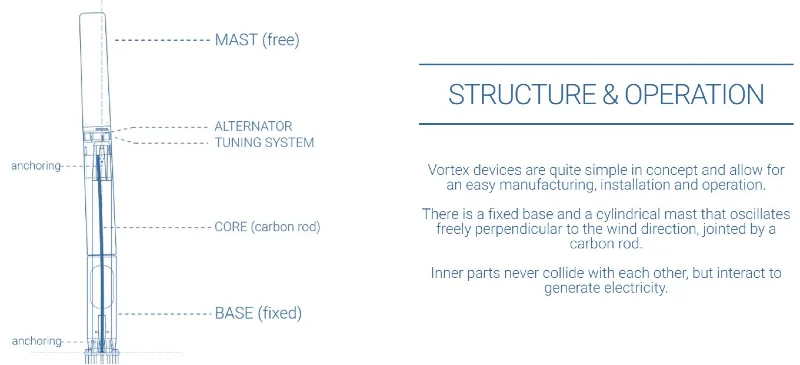
The oscillation of the fixed structure is permitted due to the elastic carbon rod in the middle which is subject to cyclical bending loads. A fatigue estimate from their green paper suggests a device could last close to 20 years before needing replacement.
This means that its maintenance costs during this period are theorized to be dramatically smaller due to the lack of moving parts compared to small turbines, which have a series of axles and gears that require monitoring and oiling, like a bicycle chain.
So if production and maintenance costs are lower, if they manage to get the device to produce comparable amounts of energy to turbines, its life-cycle cost per kWh or LCOE (Levelised Cost of Energy) would also be much lower.
Ideal in urban environments
As we discussed earlier, space comes at a premium in urban areas. Since the Vortex’s sweep area is much smaller than that of a horizontal-axis turbine it can be more easily installed in tight areas, and is totally orientation-agnostic as it can oscillate in any direction.
Also, the devices can be densely packed into a small area given that their minimum separation is equal to half the height of each Vortex wind generator, with the installation of solar panels between the devices another possibility for diversified micro-generation.
This dual solar-wind energy integration could be a niche unique to Vortex as both horizontal and vertical axis turbines create too much shade and have larger spacings. This is particularly true for their flagship Tacoma model which is 2.75m high.
On top of this, the latest noise analyses suggest that these devices operate silently and are bird-friendly, which are important when building in the city (well, some would certainly see a weapon against pigeons favourably…)
If it’s so amazing, why is it not out yet?
The reality in all start-up scenes is that out of a million great ideas, only very few actually make it to the market, and even fewer actually succeed.
Perhaps technical delays?
This could be due to funding issues, organisational problems or simply not being able to deliver on their promise. The worrying thing about Vortex Bladeless is that the company was founded in 2014, and 8 years later there is still no product available in the market.
At least at first glance, Vortex doesn’t look like another ‘zombie’ startup. Their social media account shows plenty of activity, from real-scenario testing on a Spanish rooftop, to research papers on the device’s noise testing and modelling, so perhaps the issue is simply technical.
There may be hurdles in the scaling-up to mass production, problems with their complex ‘tuning’ and ‘braking’ mechanisms, or simply not enough data on their stress tests to meet the often stringent European regulations.
Other potential issues
The stellar wind power YouTuber Rosie covered it in an extensive video in which she raised a couple of concerns.
Firstly, even when the Vortex can produce energy at very low wind speeds of 10km/h, which most turbines cannot, the power output would only reach 3W, which is relatively insignificant.
But at higher speeds, a small horizontal turbine almost doubles the output of both vertical turbines and this oscillating device (at the expense of being hard to install in the urban environment).
The company also announced plans to scale up its devices to compete against colossal wind turbines, but the YouTuber doesn’t believe that the technology is able to compete in this arena with the energy generation from oscillation being significantly less efficient than that of well-researched turbines.
Conclusion
This technology is certainly promising for this small-scale, renewable niche. In combination with solar panels and batteries, a system that includes the Vortex could perhaps give households and small businesses energy independence.
This has become a priority for some after the current energy crisis has sent some into fuel poverty, highlighting the lack of a coherent global energy policy.
If it ever gets to market, Vortex devices would probably be the most adaptable wind technologies, allowing even the smallest households to have some energy independence.
But besides this empowering (and perhaps romantic) notion of energy independence, there is the issue of economies of scale. Large wind infrastructure is simply more efficient per kWh, as the power output is proportional to the square of the wind speed.
Giant offshore turbines can tap into high-quality, low-turbulence winds, while developing kite technology will be able to tap into even higher altitudes, making micro-generation of energy within the urban environment less important for the global energy transition.
So which is more important, the energy transition or energy independence?
We think both! Let’s keep allocating resources to promising tech.
Resources
- Vortex Bladeless
- Vortex Bladeless – Noise Analysis
- Wikipedia – Vortex Bladeless
- Wikipedia – Vortex Shedding
- Wikipedia – Tacoma Bridge
- Youtube – Undecided with Matt Ferrell – Solid State Wind Energy
- Youtube – Undecided with Matt Ferrell – Rooftop Wind Turbines
- Youtube – Synergy Files
- Undecided
- Halcium
- Youtube – Just have a Think
- Youtube – Engineering with Rosie – VAWT
- Youtube – Engineering with Rosie – VAWT2
- Youtube – Engineering with Rosie – Future of Wind Energy
- Youtube – Engineering with Rosie – Vortex Bladeless
- wind-works.org
- AltAir
- AquaSwitch blogs (multiple)

